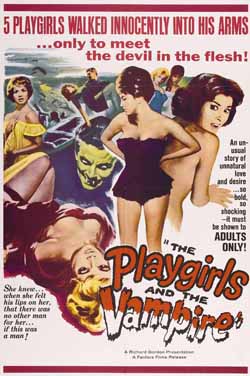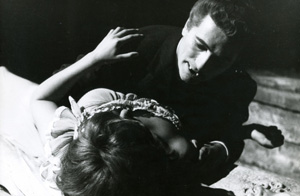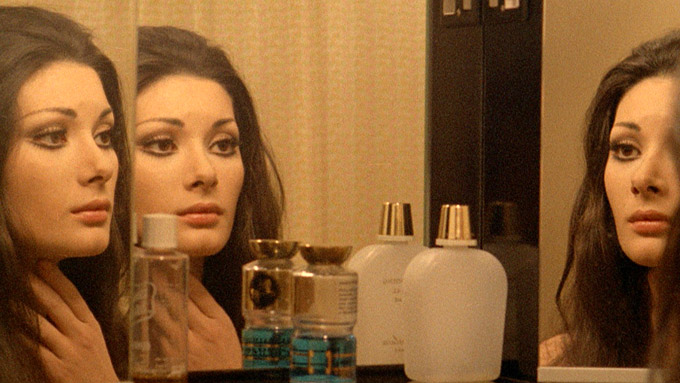
Director: Piero Regnoli
Writer: Piero Regnoli
Stars: Walter Brandi, Lyla Rocco, Maria Giovannini
A gaggle of uppity showgirls and their dodgy manager Lukas (Alfredo Rizzo) are caught in a storm and find the road blocked by some fallen trees. Reluctant to return to their previous hotel, which they’d left without paying, they decide to ignore the advice of a helpful rustic chappie and aim for a local castle in the hope of shelter. When they arrive, they receive a decidedly cold reception from the caretaker (‘Zoltan’) and housekeeper.
The owner, Count Karnessy (Walter Brandi), allows them to stay for the night on the condition that they do not leave their rooms once the sun has gone down. He also seems strangely afflicted once he catches sight of Vera (Lyla Rocco), but she’s acting pretty peculiarly herself – almost as though she’s been there before.
That night Katya (Maria Giovannini), a truly dim broad in a baby-doll nightie, goes exploring and is attacked by an unseen figure with pasty hands. In the morning her body is found at the foot of the castle walls, as though she had fallen – or been pushed – from a window. It also becomes apparent that severe flooding has succeeded in making it completely impossible for them to leave.
Understandably nervous and grieving for their friend, the showgirls decide to do what showgirls do best: practice their dance moves. And boy, are they terrible. None of them have any sense of shame, let alone rhythm. It all ends in an impromptu (and entirely unnecessary) striptease, which annoys the housekeeper no end (but undoubtedly perks up any males who happen to be in the audience).
Vera soon discovers the portrait of a woman who looks disconcertingly similar to her. Karnessy explains that it is of Marguerita, an ancestor of his, and that it was the resemblance that had originally caught him off-guard when they met. He goes on to warn her that she should leave immediately, and alludes to some kind of curse on his family name. Perturbed, she goes for a stroll in the garden; only to find that Katya’s grave has been excavated.
So what is the count’s secret? Why does Vera seem to recognise her surroundings? And, most importantly, how long will it be before we discover the castle, as is the want of such buildings, has a ready-made hidden laboratory in the basement?

The Playgirls and the Vampire is a modest, but rather agreeable, entry in the Italian Gothic canon. Released in the same year as Mario Bava’s superlative Black Sunday, it has none of the bravado (or perverse undertones) of that production. Granted, it does have many staples of the genre (hands feeling their way out of tombs, buxom babes in basques, secret tunnels, terrible dubbing). Overall, however, it comes across more as an updating of a forties horror filler; you almost expect Abbot & Costello to appear at any moment (or, even worse, Franco & Ciccio).
Although it falls way short when compared to the best examples of the genre, that doesn’t mean that there’s nothing to enjoy. The continually bitching, realistically braindead showgirls are a riot, prancing around the baroque surroundings in their flimsy undergarments and coming out with lines such as ‘…if you want more crumpets, all you have to do is ask!’ I was also particularly taken with the scene in which Vera, searching some subterranean caverns, is startled by some bats that sound like records being scratched (half leading me to expect that the mysterious events are all the work of a mentally tortured breakbeat DJ). There’s also the startling revelation that, far from becoming speechless mirrors of their former selves, the undead are pretty much the same as they were when they were alive. Which makes me thank the Lord that no one has ever thought to vampirise Tony Blair – or have they?
Regnoli’s direction is capable enough. OK, he’s no Bava (or Margheriti, or Freda, or even Mastrocinque) but he keeps things moving fairly enough, and is certainly no worse than other bargain basement genre practitioners such as Massimo Pupillo and Roberto Mauri. Good use is made of the black & white cinematography, but probably his wisest move is to keep the running time down to a mere 83 minutes (or 76 minutes for the American version released by Richard Gordon).
One major minus point is the presence of charisma bypass victim Walter Brandi in the lead role. Despite his tasty pinstripe blazer he’s dreadfully stilted and, even with badly died grey sideburns, looks more like a crap sidekick from a 70’s cop series than a tragic hero. Fortunately Alfredo Rizzo, who would also go on to become a second string (OK, second rate) director, is allowed to ham it up wonderfully – which almost, but not quite, makes up for it.
